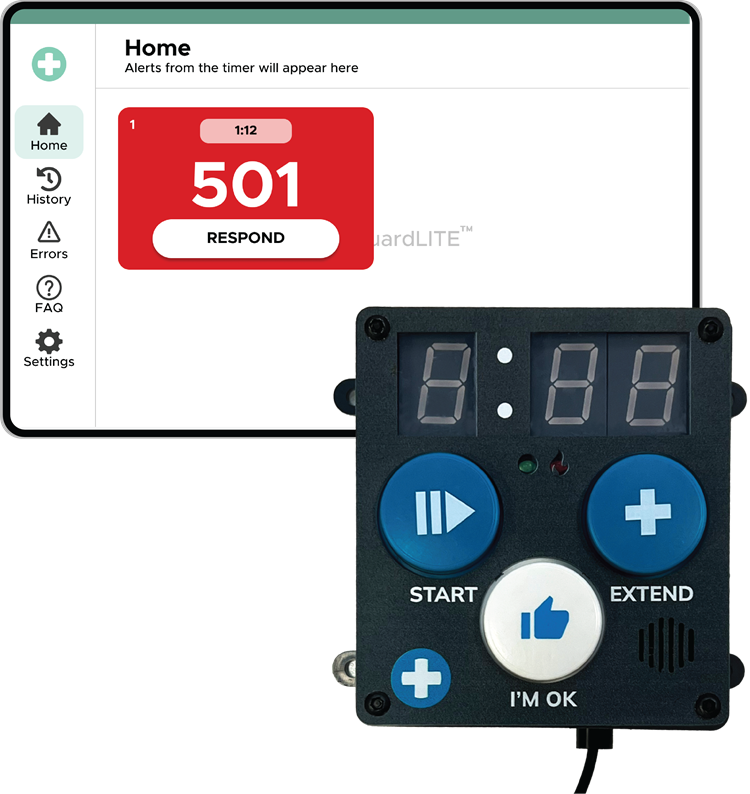Canadian company Lifeguard Digital Health has launched a drug overdose prevention device developed in partnership with Single Room Occupancy (SRO) and social housing residents. The ‘LifeguardLite™’ system will promptly alert emergency services in the case of a suspected overdose, using the cellular connectivity provided by Nordic Semiconductor’s
nRF9160 SiP.
The mains-powered device allows residents to set a timer when they’re about to consume a substance. After finishing their substance consumption, residents can press the “I’m OK” button. Should the resident then not extend (using the “Extend” button) or cancel the timer, an alarm will sound for the last ten seconds of the allotted time, and if the alarm is still not switched off during that time the device will notify both building administration and emergency medical services. Residents can also use the solution to alert staff of other emergencies, simply by pressing the “Start” button and letting the timer expire.
“The intended target market for the LifeguardLite is organizations that manage social housing buildings, as the devices can be installed in individual rooms,” says Jeff Hardy, CEO at Lifeguard. “There is also significant opportunity for this solution in other areas where there are high incidents of overdoses, such as public bathrooms, supervised consumption sites, and other harm reduction services.”
Powerful processing capabilities
The LifeguardLite system is equipped with additional safety features, in the form of a temperature sensor to detect heatstroke, and a smoke detector sensor designed to recognize nearby smoke alarms by analyzing typical sound patterns and frequencies. In the event of a suspected emergency, the device triggers an alert to the front desk admin staff. Staff can also issue an evacuation alert to all devices, notifying residents that they need to leave the building.
The nRF9160 SiP provides the necessary computational power for the device, using its dedicated 64 MHz Arm® Cortex®-M33 application processor to manage features such as the timer, temperature monitoring, smoke alarm algorithm, and overall device control. The nRF9160 SiP’s multimode LTE-M/NB-IoT modem with integrated RF Front End (RFFE) offers -108 dBm RX sensitivity in LTE-M, and -114 dBm RX sensitivity in NB-IoT mode. The class leading sensitivity ensures a better RF link budget for greater range than competitive solutions.
Nordic-powered cellular IoT
“Using cellular connectivity—rather than relying on Wi-Fi or other such solutions—has helped improve reliability, which is paramount in this use case,” explains Hardy. “Furthermore, the Nordic SiP’s cellular connection out-performed other mobile devices in buildings during our testing – which is especially important in social housing properties which are often older brick- or semi-permanent modular-buildings that can interfere with RF signals.”
Because the nRF9160 SiP can combine cellular network location data with GNSS trilateration for precise position monitoring, it also provides recovery options in the event of lost or stolen LifeguardLite devices. In addition, the device’s magnetic reed switch triggers a notification to building administration should the device be removed from the wall.
The solution includes an Android-compatible companion app installed on the supplied tablet, facilitating device management. The app provides alerts, tracks outcomes, displays errors, and offers system customization options. Users can also configure alerts through various channels, including email, SMS, and phone calls.
“We chose the Nordic SiP primarily for its impressive cellular capabilities and overall excellent performance,” says Hardy. “The large onboard Flash memory and certification across multiple countries were also key factors in our decision. The well-informed application engineers, thriving online community, detailed reference designs and exceptional customer support from the Nordic team further confirmed our decision.”

